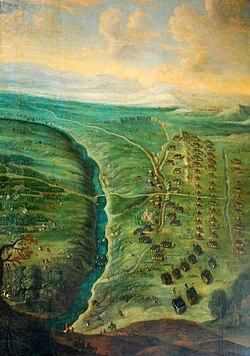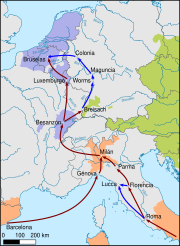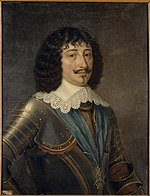Battle of Les Avins
| Battle of Les Avins | |||||||
|---|---|---|---|---|---|---|---|
| Part of theFranco-Spanish War (1635–59) | |||||||
 Battle site; Spanish forces at left, French below | |||||||
| |||||||
| Belligerents | |||||||
|
|
| ||||||
| Commanders and leaders | |||||||
|
Carignano Bucquoy Count Feria (POW) | |||||||
| Strength | |||||||
| c.27,000[1][2][3] | c.16,000[2][1][4] | ||||||
| Casualties and losses | |||||||
| 3,000 dead or wounded[2] | 4,000 to 5,000 dead, wounded, or captured[1][2] | ||||||
TheBattle of Les Avins[a]took place on 20 May 1635, outside the town of Les Avins, nearHuyin modernBelgium,then part of theBishopric of Liège.It was the first major engagement of the 1635 to 1659Franco-Spanish War,a connected conflict of theThirty Years' War.
Prior to 1635,Francehad provided financial and diplomatic support for theDutch Republicin itswar of independencefromSpain,but avoided direct involvement. In February 1635, the two countries agreed to divide theSpanish Netherlands,and following a formal declaration of war, a French army of 27,000 entered Liège in May.
Intending to link up with the Dutch atMaastrichtand attackLeuven,they ran into a Spanish force of around 16,000 outside Les Avins. The French made a series of frontal assaults and eventually over-ran their positions, forcing the Spanish to retreat.
Background
[edit]17th century Europe was dominated by the struggle between theBourbonkings ofFrance,and theirHabsburgrivals inSpainand theHoly Roman Empire.In 1938, historianCV Wedgwoodargued the 1618 to 1648Thirty Years Warand the 1568 to 1648Dutch revoltformed part of a wider, ongoing European struggle, with the Habsburg-Bourbon conflict at its centre. A view now generally accepted by modern historians, this makes the Franco-Spanish War a connected conflict, which is essential to understanding strategic objectives.[5]
Habsburg territories in theSpanish Netherlands,Franche-Comté,and thePyreneesblocked French expansion, and made it vulnerable to invasion. Occupied by domesticHuguenot rebellionsfrom 1622 to 1630, France looked for opportunities to weaken the Habsburgs, while avoiding direct conflict.[6]This included supporting the Dutch against Spain, and financingSwedishintervention in the Empire, starting in 1630, whenGustavus Adolphus of SwedeninvadedPomerania.[7]

Purple:Spanishdependencies
Green:Ruled byAustria
Brown:Ruled bySpain
When fighting restarted at the end of theTwelve Years' Trucein 1621, the Spanish initially won a series of victories but by 1633 were on the retreat. The powerfulAmsterdammercantile lobby saw this as an opportunity to end the war on favourable terms, and although negotiations ended without result, the Dutch peace party grew in strength.[8]At the same time, defeat atNördlingenin September 1634 forced the Swedes to retreat, while most of their German allies left the war after the 1635Treaty of Prague.[9]
Concerned by the prospect of the Habsburgs making peace on favourable terms in both the Empire and the Netherlands,Louis XIIIand his chief ministerRichelieudecided on direct intervention. In February 1635, they signed an alliance with the Dutch, agreeing to divide theSpanish Netherlands,followed in April by theTreaty of Compiègnewith Sweden.[10]
Much of the fighting focused on different parts of theSpanish Road,an overland supply route connecting Spanish possessions inNorthern ItalytoFlanders.After 1601, it was rarely used for moving soldiers, but remained vital for trade, and went through areas essential to French security. At the start of 1635, France had a total of around 100,000 men under arms, including 27,000 men underUrbain de Maillé-BrézéinPicardyand additional armies inChampagne,Lorraine,theSarre,and theValtellina.[11]This allowed them to threaten the Road at a number of points, but the 1635 campaign showed their logistics were inadequate to support these numbers, while there was very little co-ordination between the different theatres.[12]
Battle
[edit]In May, Louis XIII declared war on Spain, claiming to be responding to a request for support from theElector of Trier,whose territories were an important part of the Road and had been occupied by Spanish troops.[13]The French entered thePrince-Bishopric of Liège,last point in the Road, in two divisions, one led by Maillé-Brézé and the other byChâtillon.Their intention was to link up with Dutch forces based atMaastricht,underFrederick Henry, Prince of Orange,and then attackLeuven.Outside Les Avins, they made contact with a Spanish force of around 16,000,[b]commanded byThomas Francis, Prince of Carignanoand his deputiesBucquoyand Count Feria.[c][16]
The Spanish had been ordered to simply act as a blocking force but Carignano allowed himself to be drawn into battle with a larger army.[1]Although inferior in numbers, his troops were more experienced and held a strong position, with the infantry placed behind a series of hedges and artillery covering the approaches. The French commanders debated whether to attack, before deciding retreat would be more dangerous. Their artillery commander,Charles de La Porte,positioned his guns to provide covering fire; Châtillon and Maillé-Brézé drew up their troops in standard formation, infantry in the centre and cavalry on the wings, before launching a frontal assault.[16]
On the right, Maillé-Brézé was initially repulsed with heavy losses, before rallying and attacking again. On the left and centre, Châtillon attacked the Spanish artillery with 4,000 men and eventually over-ran their positions by weight of numbers. Seeing this, the French reserve of 5,000 came up and assuming this to be a new army, Carignano ordered a general retreat.[17]Most of the Spanish casualties occurred in this phase of the battle; estimates range from a total of 4,000,[1]to 5,000 including prisoners, among them Charles of Austria, nephew ofEmperor Ferdinandand Feria.[17]French losses were around 3,000, mostly incurred in their assault.[17]
Aftermath
[edit]
News of the victory was received inPariswith elation, and led to unrealistic optimism about the rest of the campaign. It also caused friction between the French commanders, with Châtillon claiming he had been sidelined to ensure Maillé-Brézé won the glory.[18]
After linking up with the Dutch, their combined force totalled around 45,000 men, but Fredrick Henry insisted on takingTienen,a place of limited strategic value.Cardinal-Infante Ferdinand of Austria,governor of the Spanish Netherlands, withdrew to Leuven, leaving a garrison of 1,200 at Tienen. When captured on 10 June, the town was sacked, over 200 civilians killed and many buildings damaged, including Catholic churches and monasteries. This atrocity undermined efforts to win over the predominately Catholic population of the Southern Netherlands and was particularly embarrassing for Richelieu, aCardinalin the Catholic church.[19]
Until the advent of railways in the 19th century, water was the primary means of bulk transportation; Leuven's position on theRiver Dylemade its capture essential for an offensive intoBrabant.By the time the Franco-Dutch armybegan the siegeon 24 June, desertion due to lack of food or pay had reduced the French army to under 17,000. When a Spanish force advanced on Leuven in early July, the siege was abandoned; on 28 July, the loss of the Dutch fortress ofSchenkenschansprompted Frederick Henry to withdraw from the Spanish Netherlands and march to its relief.[20]
Notes
[edit]References
[edit]- ^abcdeGuthrie 2003,p. 190.
- ^abcdBodart 1908,p. 59.
- ^Périni 1896,p. 175.
- ^Périni 1896,p. 176.
- ^Sutherland 1992,pp. 588–595.
- ^Hayden 1973,pp. 1–23.
- ^Wedgwood 1938,pp. 385–386.
- ^Israel 1995,pp. 521–523.
- ^Knox 2017,pp. 182–183.
- ^Poot 2013,pp. 120–122.
- ^Thion 2013,p. 20.
- ^Wilson 1976,p. 259.
- ^Forsberg 2016,p. 73.
- ^del Valle 1911,p. 59.
- ^León 2009,p. 257.
- ^abPérini 1896,p. 177.
- ^abcPérini 1896,p. 178.
- ^Parrott 2001,p. 113.
- ^Lasaffer 2006,pp. 3–4.
- ^Asbach & Schröder 2014,pp. 169–170.
Sources
[edit]- Asbach, Olaf; Schröder, Peter (2014).The Dutch-French Invasion, 1635–1646 in The Ashgate Research Companion to the Thirty Years' War.Ashgate.ISBN978-1409406297.
- Bodart, Gaston (1908).Militär-historisches Kriegs-Lexikon (1618–1905).Retrieved3 February2023.
- del Valle, José León Sancho Rayón (1911).Varias relaciones de los estados de Flandes, 1631 á 1656(in Spanish). Libos españoles raros y curiosos (1631–1656).
- Forsberg, Anna Maria (2016).Story of War: Church & Propaganda in France & Sweden in 1610–1710.Nordic Academic Press.ISBN978-9188168665.
- Guthrie, William (2003).The Later Thirty Years War: From the Battle of Wittstock to the Treaty of Westphalia.Greenwood Press.ISBN0-313-32408-5.
- Hayden, J Michael (1973). "Continuity in the France of Henry IV and Louis XIII: French Foreign Policy, 1598-1615".The Journal of Modern History.45(1):1–23.doi:10.1086/240888.JSTOR1877591.S2CID144914347.
- Israel, Jonathan (1995).Spain in the Low Countries, (1635-1643) in Spain, Europe and the Atlantic: Essays in Honour of John H. Elliott.Cambridge University Press.ISBN978-0521470452.
- Knox, Bill (2017). "The 1635 Treaty of Prague; a failed settlement?". In Tucker, Spencer (ed.).Enduring Controversies in Military History, Volume I: Critical Analyses and Context.Greenwood Press.ISBN978-1440841194.
- Lasaffer, Randall (2006). "Siege Warfare and the Early Modern Laws of War".Tilburg Working Paper Series on Jurisprudence and Legal History.06(1).
- León, Fernando González de (2009).The Road to Rocroi: Class, Culture and Command in the Spanish Army of Flanders, 1567-1659.Brill.ISBN978-9004170827.
- Parrott, David (2001).Richelieu's Army: War, Government and Society in France, 1624–1642.Cambridge University Press.ISBN978-0521792097.
- Périni, Hardÿ de (1896).Batailles françaises, Volume III(in French). Ernest Flammarion.
- Poot, Anton (2013).Crucial years in Anglo-Dutch relations (1625–1642): the political and diplomatic contacts.Uitgeverij Verloren.ISBN978-9087043803.
- Sutherland, NM (1992). "The Origins of the Thirty Years War and the Structure of European Politics".English Historical Review.107(424).
- Thion, Stephane (2013).French Armies of the Thirty Years War (Soldiers of the Past).Histoire et Collections.ISBN978-2917747018.
- Wedgwood, CV (1938).The Thirty Years War(2005 ed.). New York Review of Books.ISBN978-1590171462.
- Wilson, Charles (1976).Transformation of Europe, 1558-1648.Littlehampton Book Services.ISBN978-0297770152.

